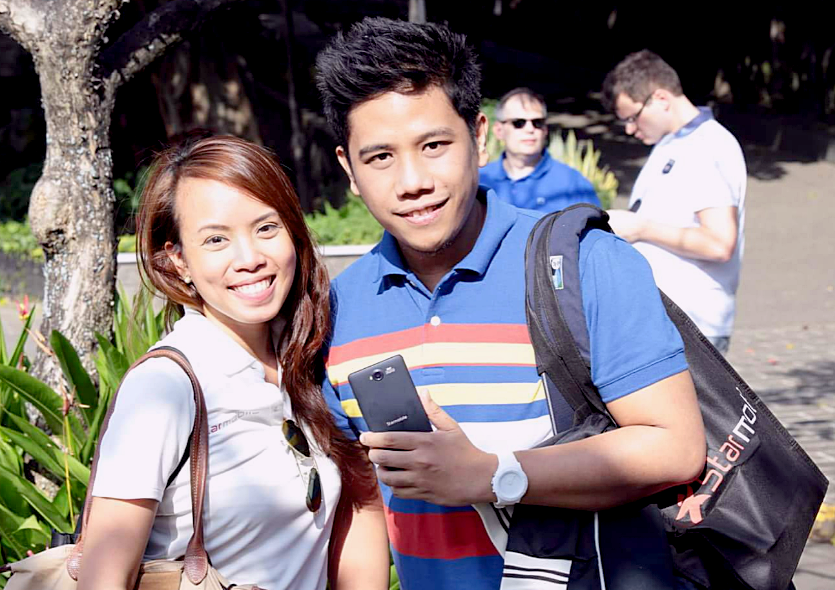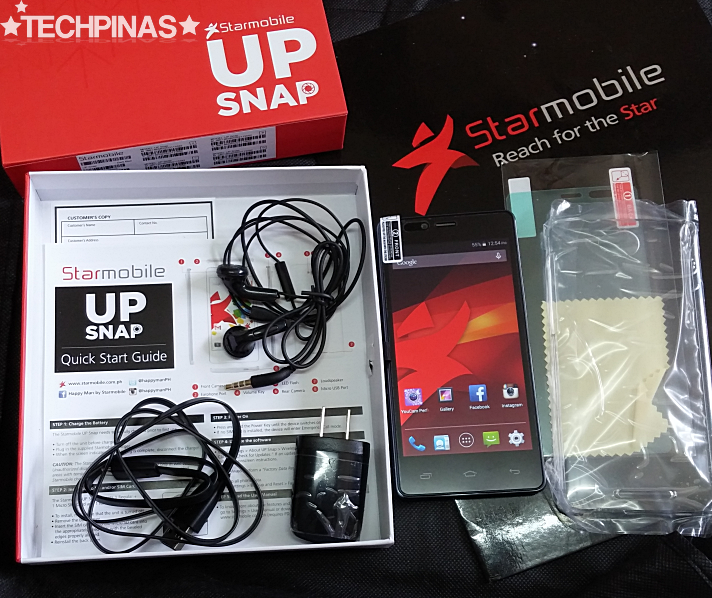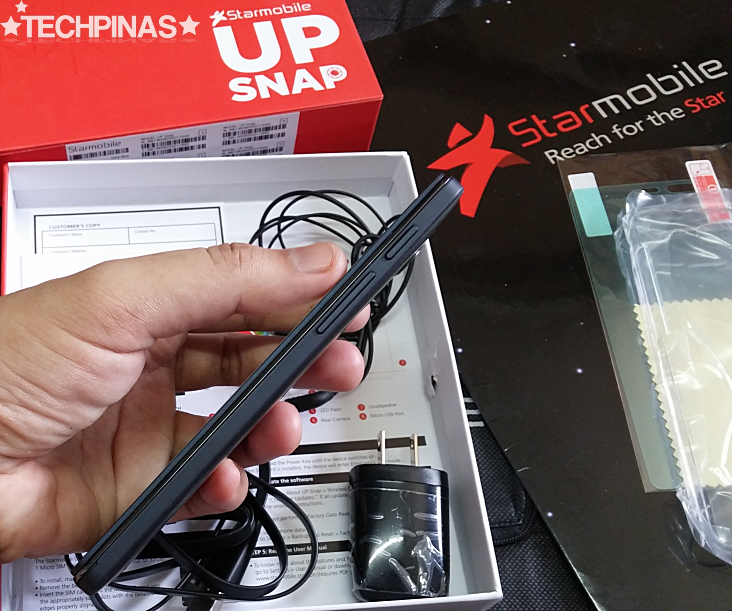Starmobile Up Snap Unboxing and Sample Camera Shots From Tour of Old Manila
Last Tuesday - February 24, 2015, I graced Starmobile's invitation for a unique launch of one of their much-talked about midrange smartphones.
Unlike many 'handset unveiling' events that I've attended in my seven years as a tech blogger (most of which were held at hotels, restaurants, large conference rooms, etc.), this one is different and is quite special as it involves a tour around some historical landmarks of Old Manila, including Fort Santiago, San Agustin Church, and the Walls of Intramuros.

As some of you know, I was born and raised in Tondo, which is at the heart of Manila. Yet, for some reason, I've been to Fort Santiago and San Agustin Church only around three times, which is something I'm not particularly proud of. So when I read in the invitation that Starmobile intends to give us a tour around those places, I immediately said 'Yes'.

So what's the connection between a Starmobile handset and this Old Manila tour, you ask? Well, apart from giving tech bloggers and members of the media a chance to revisit these historical spots with the guidance of 'Manila for a Day' Tours, it also allowed the company to showcase the indoor and low-light imaging capabilities as well as the long uptime of Starmobile Up Snap.
"On this tour, you will see paintings, statues, and actual evidence of our rich political and religious history, fragments of the past that stood the test of time. There’ll be a lot of great sights on this tour, but luckily you’ll be able to preserve these memories with the help of your Starmobile UP Snap phone," our tour guide Dustin Ancheta said.

All of us were provided a complete retail package of Starmobile Up Snap that we then used to take photos and to share them on Facebook, Twitter, and Instagram.






Alright! Now, I want to share with you the photos that I took using Starmobile Up Snap. Kindly click on the 'unedited' shots for larger view.
Fort Santiago
San Agustin Church
Manila Collectible Co. (where we had our merienda)
Intramuros
Bayleaf Hotel (where we had our dinner)
In hindsight, there are two cool things I learned from this very educational Old Manila tour. First is that my hometown has an amazing heritage as well as cultural jewels that are just waiting to be revisited and experienced by fellow Filipinos and foreign tourists alike. And second, (and this is more on the techy side) Starmobile Up Snap is definitely one of the best smartphones for imaging that you can get for less than Php 6,000. Thanks for this memorable adventure, Starmobile!
Unlike many 'handset unveiling' events that I've attended in my seven years as a tech blogger (most of which were held at hotels, restaurants, large conference rooms, etc.), this one is different and is quite special as it involves a tour around some historical landmarks of Old Manila, including Fort Santiago, San Agustin Church, and the Walls of Intramuros.

At Fort Santiago with Miss Paula Rivera, Brand Manager of Starmobile
As some of you know, I was born and raised in Tondo, which is at the heart of Manila. Yet, for some reason, I've been to Fort Santiago and San Agustin Church only around three times, which is something I'm not particularly proud of. So when I read in the invitation that Starmobile intends to give us a tour around those places, I immediately said 'Yes'.

So what's the connection between a Starmobile handset and this Old Manila tour, you ask? Well, apart from giving tech bloggers and members of the media a chance to revisit these historical spots with the guidance of 'Manila for a Day' Tours, it also allowed the company to showcase the indoor and low-light imaging capabilities as well as the long uptime of Starmobile Up Snap.
"On this tour, you will see paintings, statues, and actual evidence of our rich political and religious history, fragments of the past that stood the test of time. There’ll be a lot of great sights on this tour, but luckily you’ll be able to preserve these memories with the help of your Starmobile UP Snap phone," our tour guide Dustin Ancheta said.

All of us were provided a complete retail package of Starmobile Up Snap that we then used to take photos and to share them on Facebook, Twitter, and Instagram.

Notice the new packaging design of Up Snap. It's a thin box with an inner container that you have to pull out from the side. I think it's very similar to that of One Plus One or Huawei Ascend P7.

The complete retail includes the unit itself, the travel charger, microUSB to USB connector cable with flat wire, earphones with microphone, Quick Start Guide and warranty certificate. Starmobile also generously threw in a free screen protector and plastic case.

Starmobile Up Snap features a 5-inch 480 x 854 IPS display underneath scratch-resistant glass. It has Dual SIM Dual Standby capability and supports 3G HSPA+ mobile connection.

As its very name suggests, the highlight of this release are its dual cameras. At the back, you will find an 8 MegaPixel shooter with LED flash, f/2.0 aperture and UltraPixel sensor. These imaging specs combine to give the Up Snap stellar indoor and low-light performance that's far better than what one would usually get from a phone in this price category. In front, users get a 5 MegaPixel selfie cam with autofocus, which is a rare feature in smartphones - in any price echelon - these days.

For a phone with a large non-removable 2,900 mAh battery pack (that delivers up to 14.5 hours of talk time and 580 hours of standby), Starmobile Up Snap is quite thin - measuring only 9.5 millimeters at its thickest point.

For more information about cool and affordable Android smartphone, kindly visit our Starmobile Up Snap initial feature.
Alright! Now, I want to share with you the photos that I took using Starmobile Up Snap. Kindly click on the 'unedited' shots for larger view.
Fort Santiago
Fort Santiago (Spanish: Fuerte de Santiago, Tagalog: Moog ng Santiago) is a citadel first built by Spanish conquistador, Miguel López de Legazpi for the new established city of Manila in the Philippines. The defense fortress is part of the structures of the walled city of Manila referred to as Intramuros ("within the walls").
The fort is one of the most important historical sites in Manila. Several lives were lost in its prisons during the Spanish Colonial Period and World War II. José Rizal, the Philippine national hero, was imprisoned here before his execution in 1896. The Rizal Shrine museum displays memorabilia of the hero in their collection and the fort features, embedded onto the ground in bronze, his footsteps representing his final walk from his cell to the location of the actual execution.
It is a few hundred steps away from the Manila Cathedral and Palacio del Governador (which currently house the Commission on Elections). [wiki]
That's a statue of Dr. Jose Rizal. In contrast to statues of Andres Bonifacio, our national hero is shown here holding a book up instead of a bolo.
I won the tour's 'Best Low Light Photo' prize with this shot.
The many portraits of Jose Rizal; Some of them actually look like selfies. Hmm, do you think Jose Rizal would have taken lots of selfies too if he were alive today?
The Spaniards kept Jose Rizal in a prison cell inside Fort Santiago but he remained free.
Dr. Jose Rizal was rather sporty; This was his fencing garb.
Not sure if these were canals or passageways but these tunnels got my attention because of the serious masonry work that obviously went into making them. The builders of Intramuros are long gone -- but their work still stands to give us a glimpse of our country's colorful history.
San Agustin Church
San Agustin Church (Spanish: Iglesia de la Inmaculada Concepción de María de San Agustín) is a Roman Catholic church under the auspices of The Order of St. Augustine, located inside the historic walled city of Intramuros in Manila.
In 1993, San Agustin Church was one of four Philippine churches constructed during the Spanish colonial period to be designated as a World Heritage Site by UNESCO, under the collective title Baroque Churches of the Philippines. It was named a National Historical Landmark by the Philippine government in 1976. [wiki]
Check out the intricately designed wooden door.
During World War II, San Agustin Church 'survived the flattening of Intramuros by combined American and Filipino ground forces in May, 1945 with only its roof damaged, the only one of the seven churches in the walled city to remain standing.'
The original, un-retouched Dibella-Alberoni artwork on the ceiling of San Agustin Church.
The massive structure of San Agustin Church, 'the symmetry and splendor of its interiors, the profile of the mouldings, rosettes and sunken panels which appear as three-dimensional carvings, a baroque pulpit with the native pineapple as a motif, the grand pipe organ, the antechoir with a 16th-century crucifix, the choir seats carved in molave with ivory inlays of the 17th century and the set of 16 huge and beautiful chandeliers from Paris.'
Manila Collectible Co. (where we had our merienda)
Located just behind Manila Cathedral, Manila Collectible Co. is a Museum, Gift Shoppe, Heritage Tour and Workshop Provider all-in-one!
All of their products are 100% Filipino-made and crafted from materials sourced from the Philippines.
I highly recommend their Tsokolate con Crema. Yummy!
Intramuros
Intramuros (Latin, "within the walls") is the oldest district and historic core of the City of Manila, the capital of the Philippines. Also called the Walled City, the original city of Manila was the seat of government when the Philippines were a component realm of the Spanish Empire. Districts beyond the walls were referred as the extramuros of Manila, meaning "outside the walls".
Construction of the defensive walls was started by Spanish colonial government in the late 16th century to protect the city from foreign invasions. The 0.67-square-kilometre (0.26 sq mi) walled city was originally located along the shores of the Manila Bay, south of the entrance to Pasig River. Guarding the old city is Fort Santiago, its citadel located at the mouth of the river. Land reclamations during the early 20th-century subsequently obscured the walls and fort from the bay.
Intramuros was heavily damaged during the battle to recapture the city from the Japanese Imperial Army during the Second World War. Reconstruction of the walls was started in 1951 when Intramuros was declared a National Historical Monument, which is continued to this day by the Intramuros Administration (IA).
The Global Heritage Fund identified Intramuros as one of the 12 worldwide sites "on the verge" of irreparable loss and destruction on its 2010 report titled Saving Our Vanishing Heritage, citing its insufficient management and development pressures. [wiki]
Today, there's a golf course right outside the walls of Intramuros facing west.
But during the Spanish colonization of the Philippines, the only thing beyond this wall was Manila Bay. Now, because of 'reclamation', there's Luneta Park, Manila Hotel, etc.
Bayleaf Hotel (where we had our dinner)
Bayleaf Intramuros' must visit al fresco, roof deck View Bar is strategically located for an unobstructed viewing of the skyline, the bay and the famous Manila sunset.
In hindsight, there are two cool things I learned from this very educational Old Manila tour. First is that my hometown has an amazing heritage as well as cultural jewels that are just waiting to be revisited and experienced by fellow Filipinos and foreign tourists alike. And second, (and this is more on the techy side) Starmobile Up Snap is definitely one of the best smartphones for imaging that you can get for less than Php 6,000. Thanks for this memorable adventure, Starmobile!
Labels:
Cellphone
Featured
Filipino
Pinoy Pride
Smartphones
Starmobile
Starmobile Up Snap
Starmobile Up Snap Samsung Camera Shots
Starmobile Up Snap Unboxing








































